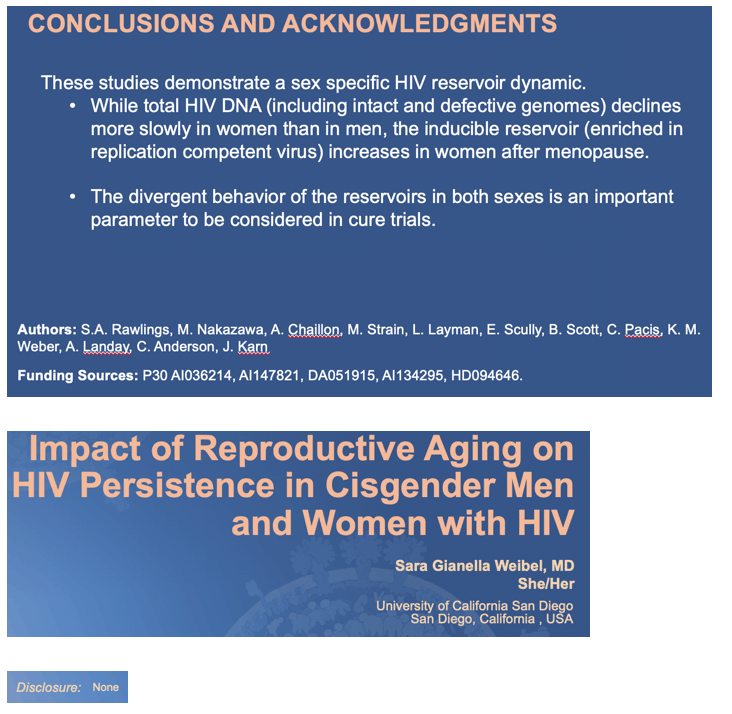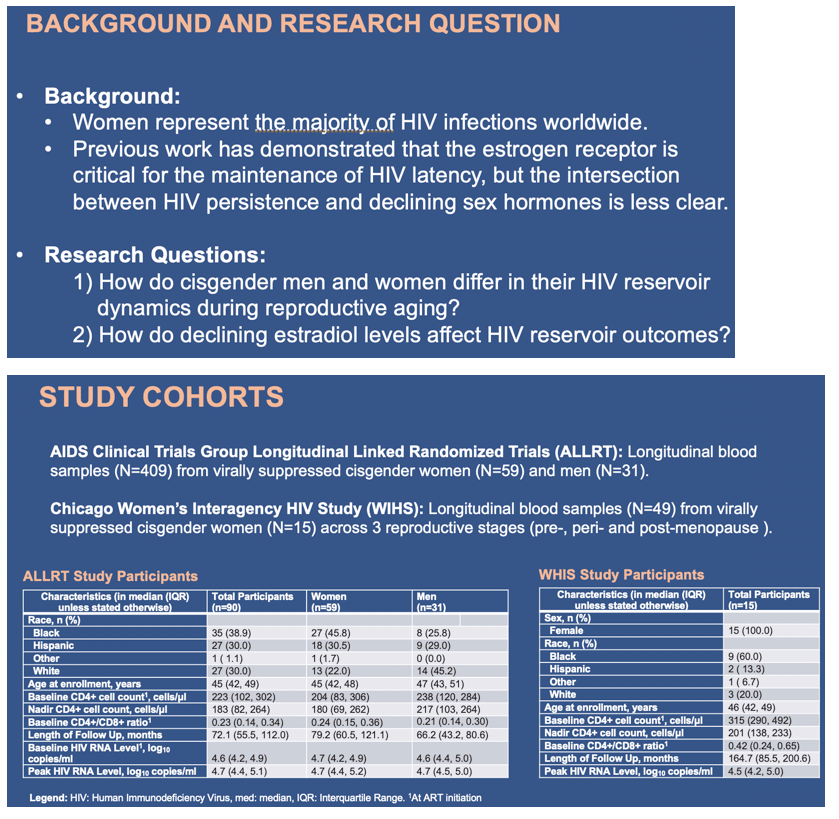 |
 |
 |
| |
IMPACT OF REPRODUCTIVE AGING ON HIV PERSISTENCE IN CISGENDER MEN AND WOMEN WITH HIV
|
| |
| |
CROI March 6-10 Reported by Jules Levin
Sara Gianella1, Stephen A. Rawlings1, Masato Nakazawa1, Antoine Chaillon1, Matthew Strain1, Laura Layman1, Eileen P. Scully2, Brianna Scott1, Caitleen Pacis3, Kathleen Weber4, Alan Landay5, Christy Anderson1, Jonathan Karn6
1University of California San Diego, San Diego, CA, USA, 2The Johns Hopkins University, Baltimore, MD, USA, 3University of California San Diego, La Jolla, CA, USA, 4The Hektoen Institute, Chicago, USA, 5Rush University, Chicago, IL, USA, 6Case Western Reserve University, Cleveland, OH, USA
Background: Women represent the majority of HIV infections, yet sex differences in HIV reservoir dynamics during reproductive aging remain an under-explored area of research..
Methods: Longitudinal samples from virally suppressed cis-gender women (N=60, 285 samples) and men (N=31, 130 samples) were retrospectively identified from the AIDS Clinical Trials Group Longitudinal Linked Randomized Trials (ALLRT) population. Participants were between the ages of 40-53 at the time of ART initiation and did not take hormonal therapy during analytic period. At each timepoint, levels of estradiol were measured by ELISA, cellular HIV DNA (total) and HIV RNA (unspliced and tatrev) were quantified by droplet digital PCR (ddPCR). Inducible HIV RNA was quantified on a subset of 132 samples from 11 participants by EDITS (measuring cell associated env mRNA after induction by TCR stimulation). We used mixed-effects model with a random participant intercept including normalized outcomes (total HIV DNA, HIV RNA and inducible HIV RNA) and sex, time since ART initiation, and the sex by time interaction as predictors.
Results: At baseline, median (IQR) CD4+ were 219 (82,324) cells/ul for women and 248 (120, 290) for men. Median age (IQR) was 45 (42,48) and 47 (43,51). Median follow up (IQR) was 93 (76,132) and 74 (52,93) months. As expected, levels of estradiol decreased among female participants (P<0.01). Overall, we observed a significant decline of total HIV DNA over time in both men and women (p<0.01). However, the rate of change significantly differed between sexes (p<0.01) with women having a significantly slower rate of decline as compared to men which becomes more pronounced with age (Figure 1). The levels of inducible HIV RNA increased over time in women but not in men during reproductive aging. We did not observe a difference in the dynamic of cell associated HIV RNA measures in the absence of ex vivo stimulation between sexes (p-values>0.17).
Conclusion: Previous work has demonstrated that the estrogen receptor is critical for the maintenance of HIV latency, but the intersection between aging and declining sex hormones is less clear. These studies demonstrate a sex specific HIV reservoir dynamic. While total HIV DNA (including intact and defective genomes) declines more slowly in women than in men, the inducible reservoir (enriched in replication competent virus) increases in women after menopause. The divergent behavior of the reservoirs in both sexes is an important parameter to be considered in cure trials.



|
| |
|
 |
 |
|
|